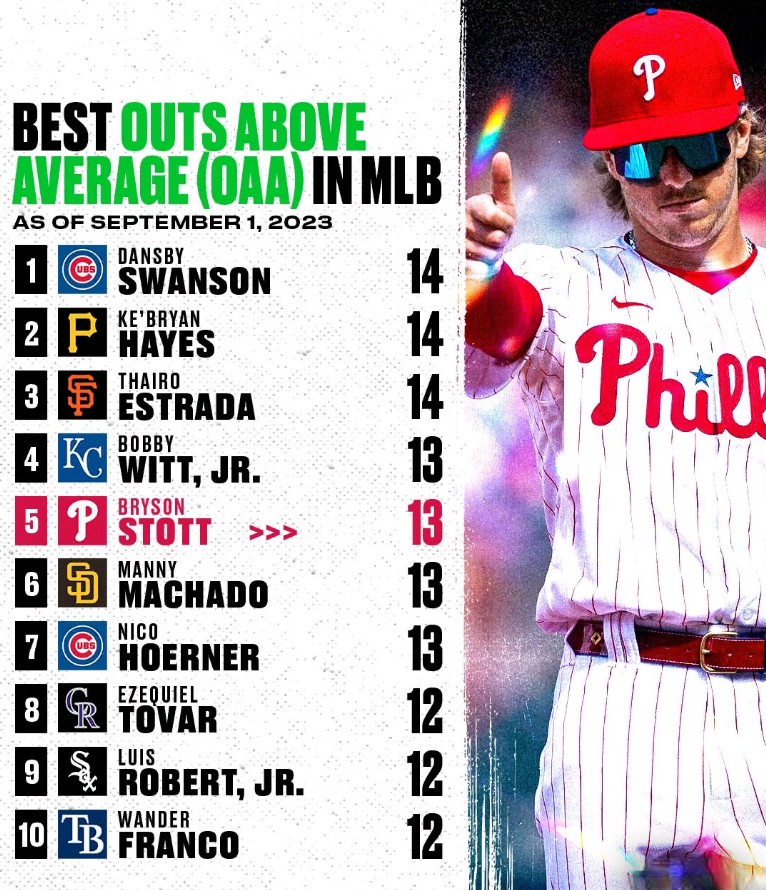Outs Above Average (OAA) has become one of the most popular advanced defensive metrics in baseball. It aims to quantify how many outs a fielder saves or costs their team compared to an average fielder at their position. In other words, OAA measures a player’s defensive impact in terms of runs prevented or allowed.
This metric matters because defense is a huge, yet often overlooked, part of the game. Stellar defenders can save many runs over the course of a season, while poor fielders can similarly cost their team precious runs. OAA provides a way to numerically capture this impact. Teams are increasingly using OAA and other advanced fielding metrics to evaluate players. For fans, OAA is a useful stat to identify the best and worst fielders in MLB.
Defining Outs Above Average

Outs Above Average (OAA) is a baseball fielding statistic that aims to quantify how many outs a fielder records above or below an average fielder at their position.
OAA measures the probability that the average fielder at that position would record an out on a specific ball in play, based on data from comparable historical plays. It then compares that expected out probability to whether or not the fielder actually made an out on the play.
For example, let’s say the average shortstop has a 90% chance of recording an out on a routine ground ball hit to them. If the shortstop fields it cleanly and gets the out, their OAA for that play would be 0 – they made the expected out.
But if they fail to make the play, their OAA would be -0.9 (-90% of an out) because they did not record the out that an average SS would have 90% of the time.
Conversely, if they made a spectacular diving play on a hard hit grounder that an average SS only had a 10% chance of fielding, their OAA for that play would be +0.9.
OAA accumulates those fractional credits and debits over the course of a season. A shortstop with +10 OAA provided his team 10 more outs than an average SS would have, while -10 OAA means 10 fewer outs.
Why OAA Matters
Defense and preventing runs are incredibly important aspects of baseball that are often overlooked compared to batting and pitching. However, many analysts argue that defense is roughly equal in value to offense. The ability to save runs on defense can greatly impact a team’s success over the course of a season.
Outs Above Average specifically measures the impact of fielding by quantifying how many outs a player records compared to an average fielder. By capturing this, it provides a simple way to quantify defensive contribution. A shortstop with a high OAA directly helps their pitching staff and prevents more scoring opportunities for the opposing team. This makes OAA one of the best publicly available metrics for understanding a player’s defensive value.
Unlike errors, OAA doesn’t just measure mistakes, but rather how much better or worse a fielder is compared to average. Even if a fielder doesn’t record many errors, they may still be below average at getting to balls and recording outs. Given the importance of preventing runs in baseball, OAA provides valuable insight into an overlooked part of the game. It can reveal elite fielders as well as defensive liabilities. Overall, understanding OAA gives greater context around a player’s total value and ability to help their team win games.
Interpreting OAA

Outs Above Average (OAA) is a statistic that measures a fielder’s effectiveness at making plays compared to an average fielder. OAA provides valuable context on fielding ability, but the scale can be challenging to interpret. What constitutes a good, bad or average OAA number?
A good rule of thumb is:
- +10 or more OAA is Gold Glove-caliber
- +5 to +10 OAA is Excellent
- +2 to +5 OAA is Above Average
- -2 to +2 OAA is Average
- -5 to -2 OAA is Below Average
- -10 or worse OAA is Poor
So a shortstop with +7 OAA would be considered an excellent defender, while a center fielder with -8 OAA would be well below average for that position. The scale is relative, so maintaining +2 OAA year after year as an aging veteran is more impressive than for a rookie.
The distribution of OAA varies by position, so an average OAA for a shortstop is around 0, while for center fielders it is around +5. This means +5 OAA would be just average for a CF, while it would be Gold Glove caliber for a SS. Always consider a player’s OAA in context of their position.
In general, an OAA of zero means a fielder made exactly as many plays as expected of an average fielder at their position over the course of a season. Positive OAA indicates making more plays than average, while negative OAA means making fewer plays. The further from zero, the more or less effective the fielder.
OAA vs Errors
While outs above average (OAA) and fielding errors are both metrics used to evaluate defensive performance in baseball, they differ significantly in their approaches.
Errors focus on plays an individual fielder should have made but did not. A fielding error is charged when a fielder misplays a ball that an average fielder at that position would make. Errors can be an misleading defensive metric, as they rely on the judgment of the official scorer and don’t account for the degree of difficulty on plays. Also, great defensive plays don’t lower errors while poor positioning or range can result in hits that don’t get charged as errors.
In contrast, OAA is a range-based metric powered by Statcast that objectively measures fielding using player tracking and batted ball data. It compares the likelihood of a fielder at a given position reaching a batted ball to the average fielder’s probability of making the play. Plays with catch probabilities over 50% where the fielder did not record an out subtract from OAA, while likely outs made add to OAA. Unlike errors, OAA accounts for play difficulty and positioning.
While errors only measure failed plays, OAA credits fielders for successful plays they make compared to an average fielder. This allows for more nuanced evaluation of overall defensive contributions. Many excellent fielders make few errors but excel at OAA by frequently making difficult plays on balls an average fielder would not reach. OAA provides a more comprehensive assessment of range, positioning, hands, and overall fielding value.
OAA Leaders and Laggards

Outs Above Average (OAA) measures a fielder’s skill at turning batted balls into outs. Some players consistently record very high or very low OAA numbers over their careers.
On the positive side, players like shortstop Andrelton Simmons, third baseman Matt Chapman, and center fielder Kevin Kiermaier have consistently posted excellent OAA numbers year after year. Simmons in particular has been elite, recording over 20 OAA multiple times in his career. His uncanny ability to get to balls and make jaw-dropping defensive plays sets him apart.
On the other end of the spectrum, players like first baseman Albert Pujols and designated hitter Nelson Cruz have consistently posted very poor OAA numbers. Their lack of defensive range and inability to track down balls has cost their teams outs over the years. As predominantly offensive players, their value comes more from their batting skills rather than any defensive contribution.
Other players may fluctuate more, posting very good OAA numbers during their athletic primes which decline as they age. But the truly elite defenders like Simmons as well as all-time greats like shortstop Ozzie Smith maintain outstanding OAA figures well into their 30s. Their defensive skills stick with them even as their offensive production wanes.
Changes Over Time
Outs Above Average (OAA) is a relatively new metric in baseball, first introduced publicly by Statcast in 2018. At that time, Statcast’s tracking technology had only been installed in all 30 MLB ballparks for a few seasons. Since the debut of OAA, the metric has continued to evolve and improve along with Statcast tracking.
In the early years of OAA, the Statcast system had more errors and inconsistencies in its tracking data. This led to occasional misattributions of outs, resulting in some skepticism about the accuracy of OAA. However, as Statcast technology has advanced, the precision of fielder tracking and subsequent OAA calculations has improved dramatically.
By 2021, most of the kinks had been worked out of the OAA system. With more data comes better baselines and expectations for fielder range at each position. Teams also optimized their ballpark setups to improve Statcast tracking fidelity. The 2021 season produced OAA results considered highly reliable compared to just a few years prior.
As a result of these tracking improvements, OAA has become more trusted and widely embraced as an advanced fielding metric. Despite its short history, OAA now rivals or exceeds UZR and DRS for predicting future defensive performance. The volatility that used to plague OAA has reduced as Statcast data quality improves each season. OAA is still not perfect, but its accuracy and utility continues to progress.
OAA in Evaluating Players

Outs Above Average has become an important statistic for teams, analysts, and fans when evaluating fielders. With the rise of advanced defensive metrics like OAA, there is now far more insight into a player’s defensive contributions beyond basic stats like errors and fielding percentage.
For front offices and scouting departments, OAA gives them a quantitative way to measure a fielder’s range, reaction times, jumps, and overall ability to turn batted balls into outs compared to an average fielder. Teams have used OAA to identify undervalued defensive players to acquire who may provide extra value in the field. It has also been used to determine where to optimally position fielders to maximize their defensive impact.
For fans and analysts, OAA provides a simple way to compare fielders across positions and eras. Leaderboards ranking players by OAA give a clear view of the elite fielders in the game. Seeing a shortstop with a high OAA shows they have great range. A top OAA corner outfielder likely gets excellent jumps and has a strong throwing arm. OAA combined with other metrics gives fans more insight into a player’s true defensive contributions.
When evaluating trades, free agent signings, or a team’s lineup construction, OAA has become an important data point to consider along with offensive stats. The rise of OAA has shone a light on defense and helped better appreciate players who provide immense value in the field, even if they lack big offensive numbers. For all involved in baseball, OAA marks a major step forward in accurately capturing and quantifying a fielder’s defensive skills.
Limitations of OAA
While Outs Above Average has become a popular advanced defensive metric in baseball, it does have some limitations to consider:
-
Range bias: OAA favors players with more opportunity to make plays, such as faster center fielders who can cover more ground. Players at certain positions are inherently going to record more OAA.
-
No accounting for positioning: OAA focuses solely on plays made and does not consider defensive positioning and alignment. A shortstop positioned well may convert more plays than one with superior range.
-
No separation of range vs. errors: OAA does not differentiate between plays not made due to lack of range vs. errors on makeable plays. Two fielders can have identical OAA but one may be better at limiting mistakes.
-
Volatility: There can be high year-to-year variance in OAA, making it difficult to assess true talent level from a single season. Multi-year samples are ideal.
-
Outfield arms: Outfielder throwing ability is not captured in OAA. A strong arm can deter baserunners while a weak one allows more tries.
-
Pitcher influence: Pitchers who induce more weak contact or flyballs can positively impact an outfielder’s OAA. Groundball/strikeout pitchers affect infield OAA.
-
Park factors: The dimensions and layout of home ballparks can impact OAA opportunities. Right field in Fenway plays much differently than in Oakland.
While a useful metric, OAA alone cannot paint a complete picture of a player’s defensive contributions. It is best analyzed alongside other fielding stats and scouting assessments. But it does capture meaningful information on range and converting chances that most defensive metrics have historically missed.
Conclusion
Outs Above Average (OAA) has become an important metric in baseball for evaluating fielding skill. This advanced defensive stat measures the number of outs a fielder records above or below an average fielder.
Throughout this article, we’ve covered what OAA is, why it’s valuable, how to interpret it, and how it compares to traditional fielding stats like errors. OAA provides a more holistic assessment of fielding contributions than errors and putouts. It accounts for factors like range and arm strength.
The leaders in OAA like Kevin Kiermaier demonstrate elite glovework at premium positions. Meanwhile, poor OAA totals can reveal fielders who may appear decent by errors but fail to get to balls an average fielder would. OAA adjusts for opportunities, making it useful for comparisons across positions.
While not perfect, OAA gives us a fuller view of defensive impact. It aims to quantify the difficulty of plays to determine if a fielder has lived up to expectations. With advanced metrics like OAA, we gain insights into a critical but overlooked aspect of the game – defense. OAA helps identify truly elite fielders and provides greater context in evaluating players overall.








